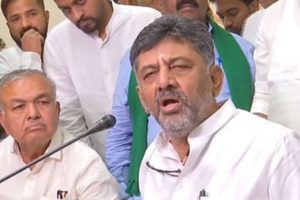Planning in India has gone through various phases: first, it was just growth, and then it was growth with equity, then again equity with growth. It delivered well when it just stuck to growth but floundered badly when issues like equality, poverty and income distribution came to the fore.
The result was that there was neither growth nor equity. This failure had several wrong policies to blame. It was largely aided and abetted by wily politicians ~ and aid organisations ~ blaming the rich, and the wealthy heaping blame on the poor for stagnation in the economy. The only people to profit from the situation were the populist politicians and their sidekicks and the so-called committed economists and bureaucrats who reaped a bonanza of plum assignments and sinecure positions.
The people who suffered the most were ~ and continue to be ~ the poor who sat bowed through long discourses on poverty from political pulpits, and perhaps research students who kept furrowing through heavy tomes on the subject authored by development panjandrums. Our mistake as a generation of policymakers in India was to assume that we knew what the poor needed, that it was our job to tell them.
We never bothered to ask them first. That’s why things haven’t worked. The best approach to local development is to tap into the knowledge already available and think of ways it can be leveraged to achieve more appropriate, locally useful and sustainable development.
During the last several decades, Third World governments, backed by international aid organisations, have poured billions of dollars into cheap-credit programmes for the poor, particularly in the wake of the World Bank’s 1990 initiative to put poverty reduction at the head of its development priorities.
And yet those responsible for such transfers had, and in many cases continue to have, only the haziest of ideas of what they achieved, and how their intervention could be redesigned to improve matters. Part of the problem is that foreign aid decreases the incentives for long-term economic development. Also, the world contains unscrupulous people who strategically exploit our empathy for bad ends.
The story goes that when the International Development Association (IDA) was being set up in 1960, Prime Minister Jawaharlal Nehru asked World Bank President Eugene Black that it be engineered to administer credit, not grants. The distinction was not just financial, but philosophical: grants connoted charity and diminished the receiver; loans encouraged accountability on the part of both debtor and creditor. Although imported programmes have the benefit of supplying “pre-tested” models, they are inherently risky because they may not take root in local culture when transplanted. Home-grown models have greater chances of success.
The hundreds of millions of households that constitute the rural poor are a potential source of great wealth and creativity. Under present institutional, cultural and policy conditions, they must seek first and foremost their survival. Their poverty deprives not only them but also the rest of us of the greater value they could produce if only they were empowered and equipped with the right tools.
The government should also take a radical relook at grassroots development apparatuses. The current approach of India seems to miss the holistic nature of sustainable development, allowing the goals and targets to be divided up between different ministries and departments without identifying the inter-linkages that exist between the different goals, and this risk working in silos ~ which is unlikely to deliver.
What does social change entail and what can unlock the potential for change? 1. Sustainable social change typically includes changes at three levels: personal (behaviour and practice), social (values and social relations), and systemic (policy).
2. It invariably engages with five elements of everyday life: the individual, the family, the community, the government, and the market.
In recent times, it has been a guiding credo for development practitioners that the involvement of local communities in decisions that affect their lives is central to making development more effective, by giving them voice and agency. This is an important way to improve the role of the poor in bringing about their transformation.
We must become facilitators and start empowering communities so that they can explore solutions from within. They may resist doing the hard work of thinking through their problems and building their capacities to find solutions. But once they are empowered, their mindset will also undergo a shift.
The true development of a community involves a transformation of the state of a human being. However, such a transformation must have the active involvement and participation of those being affected by it. True development transforms groups without destroying their culture, traditions, environment, livelihood and social patterns, which must be preserved and protected because they are central to the very life of the people. The forests, for example, provide food, medicine, and livelihood to local communities, a sustainable solution to the triple whammy of food security, healthcare and employment which the state is ill-equipped to address. True development shouldn’t translate into development as seen by the elite. It must be developed as seen by those whose lives are to be transformed.
How power is exercised, negotiated and contested by diverse actors within emerging government bodies is necessary for understanding the new structures and configurations that affect developmental policy. There is a need to create a broader, deeper legitimacy for the local agency than those institutions of local governance that they see to replace. Shadow networks also have an important role. It is vital to promote the advancement of local structures ~ that are closer to local communities and their contexts.
They should not be equated with a so-called dark network which is usually inhabited by nefarious and anti-social elements. We should foster participation and growth of social capital through endogenous social networks. We should enlist new voices and local capital (especially underrepresented individuals and youth) by engaging key intermediaries, particularly through the active engagement of younger and senior citizens.
The degree to which they will succeed in pushing service delivery and enhancing citizens’ inclusion in decision-making and thus demonstrate democratic dividends will depend on how we choose to empower them. Through dividends, a democratic culture can be nurtured and expanded for sustaining the project.
First, we need to put traditional strategic planning on its head. The most legitimate vision begins with the input of citizens and then gradually evolves from community goals to concrete projects.
By bringing people together to collaboratively craft a vision for the future, ideas can lead to reality faster and with greater consensus. Second, visioning should shift from problems or needs-based thinking to assetbased thinking. Finally, visioning should balance the tough, bigpicture work with achievable projects. As futurist Joel Barker explains: “Vision without action is merely a dream. Action without vision just passes the time. Vision with action can change the world.”
Numerous factors affect community involvement. For example, the programme design can unintentionally favour the powerful elite in the community (by them being able to be more involved); intra-community divisions sometimes prevent the larger community from coming together; cooperation from local leadership could be met with difficulties, and community participation often depends on whether or not members personally perceive the benefit of participating.
That may sound straightforward, but implementation requires many stages and partnerships and a widespread public outreach campaign to educate citizens about the programme. They’re wary of risks when spending public money. Are there unintended negative consequences to your policy? Focus on concrete results, and ideally solve multiple problems.
Practically all developed nations in the world have robust public systems in place that take care of basic needs like healthcare and education. However, in India, these systems are archaic, non-inclusive and ineffective because the vested interest of private parties to control the market takes precedence over the government’s willingness to ensure general well-being.
Monitoring and evaluation ~ or measurement ~ is a critical aspect of development programmes. Funders are accountable to taxpayers and implementing agencies are similarly accountable to funders. Apart from ensuring proper accountability, measurement is a very useful aid. It can help programme teams and their partners navigate the uncertainties of programme implementation and help all with new learning that can inform other interventions and strategies.
Grant-making is not the solution. This is not to say that grants are bad; they are just one part of the solution. Aid is sometimes given badly or not in the way it should be. It is not purposeful when it is used to patch up the effects of basic differences that are built into the structure and values of society. In such cases, aid may amount to accepting the injustices of society while trying to mitigate the results of the injustices.
In small traditional communities, each successive generation is born into the rigidity of caste; each generation must bear, at some stage in his life, the incessant greed of the moneylender and the merchant and the random cruelty of nature. Despite this, the majority survives and adapts, relying on grit and their raw native wisdom.
These communities are repositories and bearers of traditional knowledge and their survival in adverse situations is accomplished by their ingenious methods of social and economic engineering. There is thus in these societies some collective wisdom for which the professional’s knowledge is not a substitute.












